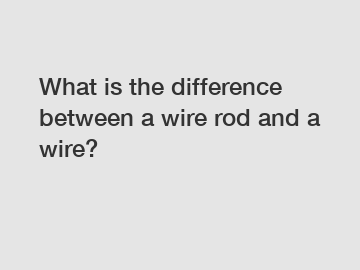What is the difference between a wire rod and a wire?
What is the difference between a wire rod and a wire?
A wire rod and a wire may seem similar, but they are actually quite different in terms of their characteristics and applications. .
A wire rod is a semi-finished product that is primarily used as a raw material for the production of wires. It has a circular cross-section and is typically produced through a hot rolling process. Wire rods are usually manufactured from steel billets and can vary in size and composition depending on the desired end product. These rods are known for their high strength and flexibility, making them suitable for further processing into wires.

On the other hand, a wire is a slender and flexible metallic product that is widely used in various industries and applications. Unlike wire rods, wires are the final product that is obtained through additional processing steps, such as drawing and annealing. Wires come in different shapes and sizes, ranging from thin strands to thick cables, depending on the intended use. They possess excellent electrical conductivity and can be easily bent, twisted, or soldered, making them suitable for applications like electrical wiring, jewelry making, and construction.
The distinction between a wire rod and a wire arises from their manufacturing processes and intended uses. Wire rods serve as the starting point for wire production as they undergo further processing steps to transform into wires. These additional steps, such as drawing, help refine the mechanical and electrical properties of the wires, ensuring they meet specific requirements for their intended applications.
The significance of understanding the difference between wire rods and wires lies in the optimization of material usage and cost-effectiveness. By using wire rods as the raw material, manufacturers can produce wires with precise dimensions, mechanical properties, and surface finishes. Furthermore, the ability to tailor the composition and microstructure of wire rods allows for the production of wires with enhanced performance characteristics, such as improved strength or corrosion resistance.
The distinction between wire rods and wires also has implications for quality control and product validation. Manufacturers must carefully monitor the properties and dimensions of wire rods to ensure consistent and reliable wire production. Additionally, understanding the characteristics of wire rods can help identify potential issues or defects that may affect the quality of the final wire product.
In conclusion, the difference between a wire rod and a wire lies in their characteristics, manufacturing processes, and applications. Wire rods serve as the starting point for wire production and undergo additional processing steps to transform into wires. Understanding this distinction is crucial for optimizing material usage, ensuring product quality, and achieving enhanced performance in various industries.
Are you interested in learning more about high quality hot rolled carbon steel coil, color-coated steel product, dull finish cold-rolled thin steel coil? Contact us today to secure an expert consultation!

Comments
0